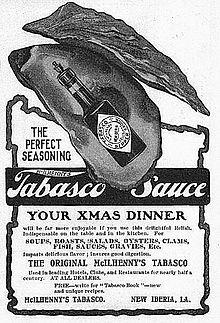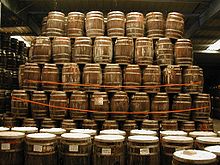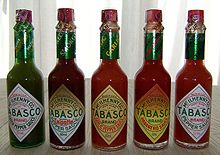Tabasco sauce
| File:Diamond logo-PSauce-outlined.gif | |
| Company type | Private (family-owned) |
|---|---|
| Industry | Food processing |
| Founded | 1868 |
| Founder | Edmund McIlhenny |
| Headquarters | Avery Island, Louisiana, United States |
| Products | Pepper sauce and other condiments |
Number of employees | About 200 (per company web site, August 2014) |
| Website | www.tabasco.com |
Tabasco sauce is a brand of hot sauce made exclusively from tabasco peppers (Capsicum frutescens var. tabasco), vinegar and salt. It has a hot, spicy flavor.
The sauce is produced by the US-based McIlhenny Company.
History

Tabasco sauce was first produced in 1868 by Edmund McIlhenny, a Maryland-born former banker who moved to Louisiana around 1840. McIlhenny initially used discarded cologne bottles to distribute his sauce to family and friends. In 1868 when he started to sell to the public he ordered thousands of new cologne bottles from a New Orleans glassworks. On his death in 1890, McIlhenny was succeeded by his eldest son, John Avery McIlhenny, who expanded and modernized the business, but resigned after a few years to join Theodore Roosevelt's volunteer cavalry regiment known as the Rough Riders.[1]
On John's departure, brother Edward Avery McIlhenny, a self-taught naturalist fresh from an Arctic adventure, assumed control of the company and also focused on expansion and modernization, running the business from 1898 until his death in 1949.
Walter S. McIlhenny in turn succeeded his uncle Edward Avery McIlhenny, serving as president of McIlhenny Company from 1949 until his death in 1985. Previously, Walter had served in the U.S. Marines during World War II, fighting at Guadalcanal and two other major battles.
Edward "Ned" McIlhenny Simmons then ran the company as president and CEO for several years, and remained chairman of the board until his death in 2012.[2] Paul McIlhenny, sixth in the line of McIlhenny men to run the business, assumed the presidency in 1998, and occupied the post of chairman until his death in early 2013.[3] In 2012, McIlhenny cousin Tony Simmons assumed the company's presidency and runs the company today.[4]
McIlhenny is one of just a limited number of U.S. companies to receive a royal warrant of appointment that certifies the company as a supplier to Queen Elizabeth II. McIlhenny is one of the 850 companies around the world that have been officially designated as suppliers to the queen by such warrants. The warrant held is "Supplier of Tabasco Sauce HM The Queen - Master of the Household - Granted in 2009".[5]
Production

Originally all peppers used in Tabasco sauce were grown on Avery Island. Today peppers grown on the Island are used to produce seed stock, which is then shipped to foreign growers,[6] primarily in Central and South America. More predictable weather and readily available farmland in these locales allow a constant year-round supply. This ensures the availability of peppers should severe weather or other problems occur at a particular growing location.
Following company tradition, peppers are hand picked, and to ensure ripeness they are compared by pickers to a little red stick (le petit bâton rouge). Peppers are ground into a mash on the day of harvest and placed along with salt in white oak barrels (aging barrels previously used for Jack Daniel's Tennessee whiskey[7]). To prepare the barrel, the inside of the barrel is de-charred (top layer of wood is removed), torched and cleaned, to minimize the presence of any residual whiskey. The barrels are then used in warehouses on Avery Island for aging the mash.
After aging for up to three years, the mash is strained to remove skins and seeds. The resulting liquid is mixed with vinegar, stirred occasionally for a month, and then bottled as finished sauce.[8]
Much of the salt used in Tabasco production comes from an Avery Island salt mine, one of the largest in the U.S.
In 2005 Avery Island was hit hard by Hurricane Rita.[8] As a result, the family constructed a 17-foot (5.2 m)-high levee[6] around the low side of the factory and invested in back-up generators.
Varieties

Several sauces are produced under the Tabasco brand name, including jalapeño-based green, chipotle-based smoked, habanero, garlic, "sweet and spicy", and "Buffalo style" sauces. The habanero, chipotle, and garlic sauces include the tabasco peppers blended with other peppers, whereas the jalapeño variety does not include tabasco peppers. None of these have the three-year aging process the flagship product uses.
Spiciness
| Tabasco sauce | |
|---|---|
| Heat | Medium Hot (SR: 3,500–8,000) |
The original red variety of Tabasco pepper sauce measures 2,500–5,000 SHU on the Scoville scale. The habanero sauce is considerably hotter, rating above 7,000 Scoville units. The chipotle sauce adds chipotle pepper to the original sauce, measuring 1,500–2,500. The garlic variety, which blends milder peppers in with the tabasco peppers, rates 1,200–1,400 Scovilles, and the green pepper (jalapeño) sauce is even milder at 600–1,200 Scovilles. The Sweet and Spicy sauce is the mildest at only 100-600 Scoville units.[9]
Packaging


Tabasco brand pepper sauce is sold in more than 165 countries and territories and is packaged in 22 languages and dialects. The Tabasco bottle is still modeled after the cologne-style bottles used for the first batch of sauce in 1868.[6] As many as 720,000 two-ounce (57 ml) bottles of Tabasco[10] sauce are produced daily at the Tabasco factory on Avery Island. Bottles range from the common two-ounce and five-ounce (59 ml and 148 ml) bottles, up to a one US gallon-(3.8 liter) jug for food service businesses, and down to a 1/8-ounce (3.7 ml) miniature bottle. There are also 0.11-ounce portion control (PC) packets of Tabasco sauce.
One-eighth-ounce bottles of Tabasco, bearing the presidential seal, are served on Air Force One.[6] The US military has included Tabasco sauce in Meals, Ready-to-Eat (MREs) since the 1980s. The British and Canadian armies also issue small bottles of Tabasco sauce in their rations.
Uses
McIlhenny Company produces Tabasco brand products that contain pepper seasoning, including popcorn, nuts, olives, mayonnaise, mustard, steak sauce, Worcestershire sauce, soy sauce, teriyaki sauce, marinating sauce, barbecue sauce, chili sauce, pepper jelly and Bloody Mary mix. McIlhenny Company also permits other brands to use and advertise Tabasco sauce as an ingredient in their products (a common marketing practice called "co-branding"), including Spam, Slim Jim beef sticks, Heinz ketchup, A1 steak sauce, Plochman's mustard, Cheez-It crackers, Lawry's salt, Zapp's potato chips and Vlasic pickles.
The original red Tabasco sauce has a shelf life of five years when stored in a cool and dry place; other Tabasco flavors have shorter shelf lives.[11]
During the Vietnam War, Brigadier General Walter S. McIlhenny issued The Charlie Ration Cookbook.[12] (Charlie ration was the name for the field meal then given to troops.) This cookbook came wrapped around a two-ounce bottle of Tabasco sauce in a camouflaged, water-resistant container. It instructed troops how to mix C-rations to make such meals as "Combat Canapés" or "Breast of Chicken under Bullets."[13]
During the 1980s, the U.S. military began to include miniature bottles of Tabasco sauce in its MREs. Eventually, miniature bottles of Tabasco sauce were included in two-thirds of all MRE menus. During the same period, McIlhenny Company issued a new military-oriented cookbook using characters from the comic strip Beetle Bailey. Titled The Unofficial MRE Cookbook, it was offered free of charge to U.S. troops.
Tabasco appeared on the menu of NASA's space shuttle program and went into orbit on the shuttles.[13] It was on Skylab and on the International Space Station and is popular with astronauts as a means of countering the dulling of the sense of taste that they frequently experience in space.
In art and culture
The Tabasco bottle is an original design and has remained almost unchanged up to the present. It has appeared in many movies and cartoons, as well as on television. Some appearances date as far back as the Our Gang short Birthday Blues in 1932 and Charlie Chaplin's Modern Times in 1936. The bottle also graced the side of Darrell Waltrip's race car for a brief period.[6]
See also
Notes
- ^ The Economist, "Tabasco island: Some like it Avery hot", 26 March 2011, p. 40.
- ^ "WWLTV Eyewitness News Report".
- ^ "CNN News Report Paul McIlhenny". Retrieved 24 February 2013.
- ^ "Lead Changes for Tabasco, McIlhenny Company". KATC.com. Retrieved 6 March 2013.
- ^ Royal Warrant Holders Association
- ^ a b c d e Belson, Ken. (2013, February 4). Hot Sauce Maker's Ties to Football Burn Deep. The New York Times, p D8.
- ^ Mali Mish - An Airstream Travel Blog. Day 185: Tabasco Factory and Jungle Gardens at Avery Island
- ^ a b Shevory 2007, pp. B1–B4
- ^ Scoville
- ^ Shevory 2007, p. B1
- ^ FAQs | McIlhenny Company | TABASCO.com
- ^ The Charlie Ration Cookbook
- ^ a b Edwards, Bob (29 November 2002). "TABASCO's Hot History". National Public Radio. Retrieved 7 June 2008.
References
- Shevory, Kristina (31 March 2007), "The Fiery Family", The New York Times, retrieved 7 June 2008.
- Kurlansky, Mark (2002), Salt: A World History, Walker & Company, ISBN 0-8027-1373-4.
Further reading
- Rothfeder, Jeffrey, McIlhenny's Gold: How a Louisiana Family Built the Tabasco Empire, HarperCollins, Apr 21, 2009
- Bernard, Shane K. Tabasco: An Illustrated History. University Press of Mississippi, 2007. ISBN 978-0979780806.


